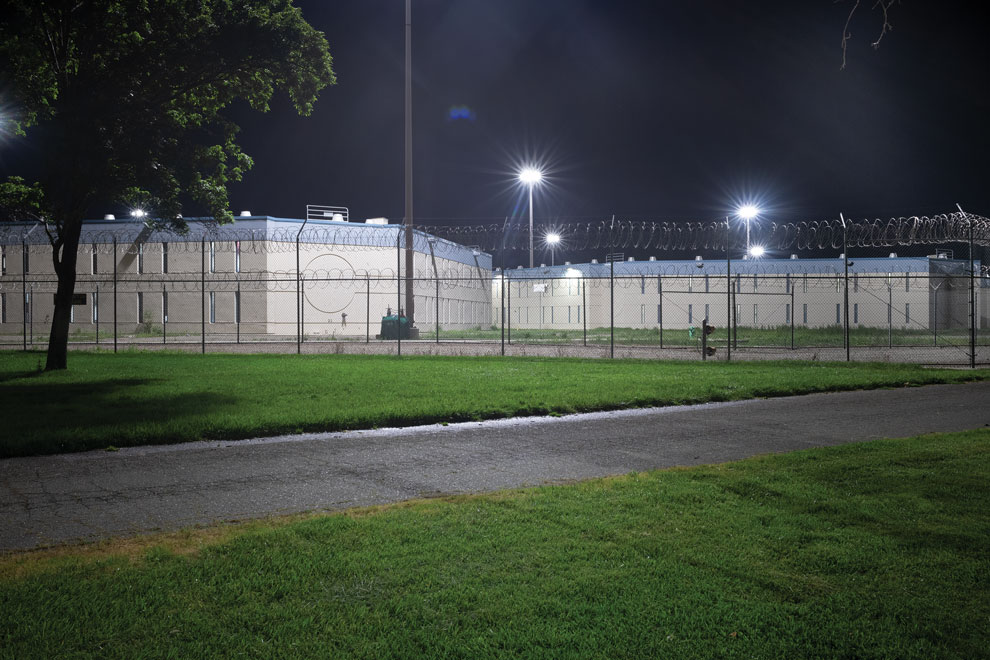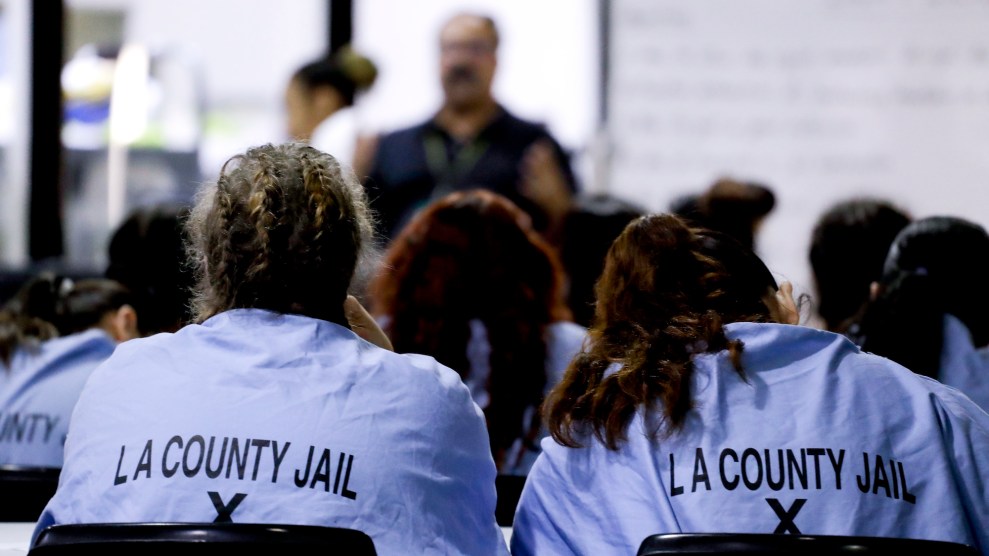The last bus of the day pulls away from the parking lot outside the Santa Rita Jail in Dublin, California, at 8:43 p.m. Twenty minutes later, a young woman pulls up the hood of her dark jacket, pushes open the jail lobby’s heavy door, and steps out into the night, looking for a cigarette.
Leah, as I’ll call her, is not the only just-released inmate trying to score a smoke. “Who’s got a fucking cigarette?” yells a man bursting through the door behind her. Near the bus stop, Leah finds a butt burned almost all the way to the filter. Clutching it, she approaches me for a lighter. I don’t have one; I offer her my cellphone instead. Leah, whose voice is shaking, wants to call her mom. She’s planning to take the train home. It’s a 35-minute trek, in the dark, to the station.
When her call goes to voicemail, Leah becomes distraught. “I don’t want to walk this path, but I will,” she says into the phone. “I love you, and I’ll see you soon, if I get there.” More than a week later, when I text her mother, she tells me Leah never made it home. Leah is an addict, she explains.
It’s not unusual for jails large and small to release inmates after dark or in the early hours of the morning. For many people released before daybreak, the hours that follow are difficult, dangerous, and sometimes deadly. Many hit the streets without phones, money, a ride, or knowledge of local public transportation, if it’s still running. They may be struggling with addiction or mental health issues; some have no place to go. In Los Angeles, men and women let out at night often find their way to nearby Skid Row. Chicago’s Cook County Jail releases people into a dangerous neighborhood after dark. (Discharged inmates often head to a local Popeyes for sanctuary.) “It’s hard to think of a more counterproductive, self-defeating measure if we want people to succeed when they get out of jail than releasing them in the middle of the night,” says David Fathi, director of the American Civil Liberties Union’s prison project.

Santa Rita County Jail in Dublin, California
Todd Hido
Eight months before I encountered Leah, Jessica St. Louis was released from Santa Rita at 1:25 a.m. on a Saturday. The 26-year-old had been picked up on minor charges before, and almost every time she was set free, “she ends up at our place,” says Benita Turner, her foster mother. Turner lives 20 minutes from the jail, but on the morning of July 28, 2018, neither St. Louis nor the jail called her. St. Louis set off alone with nothing but a transit ticket issued by the jail. The trains wouldn’t start running for several hours. She was found outside the station before daybreak, dead from an overdose of heroin laced with fentanyl, according to the county coroner’s office.
Turner still has questions about how her foster daughter died—where she found drugs in the early morning or got the money to pay for them. “We will never know the answer to that,” says Sergeant Ray Kelly, the spokesperson for the Alameda County Sheriff’s Office, which runs Santa Rita Jail. Studies show that inmates’ risk of dying is highest in the two weeks following release from jail or prison; overdoses are the most frequent cause of death. “We’ve had people leave jail and then get home and go back on drugs and overdose and die, I’m sure,” Kelly says. (The jail does hand out naloxone, a drug that reverses opioid overdoses, but only to inmates with a prescription.) If Santa Rita had discharged St. Louis at 7 a.m., would it have changed anything? “I don’t know that the hour of the night would have made a difference,” Kelly says.
Santa Rita usually lets out 50 to 100 inmates between 4:30 p.m. and 4:30 a.m. every day. Some have just posted bail. A few have been arrested late in the day for a misdemeanor like public drunkenness and let go with a citation. Those who have received a release order from a judge earlier in the day may wait in holding cells for hours while jail employees confirm their release and handle their paperwork. The process freezes three times a day during head count. Ditto if there’s a fight or other emergency.
Theoretically, approving a release could take 30 minutes, says a Santa Rita lieutenant who oversees the records department. In practice, it can take four to six hours—or eight, if the paperwork comes up late. According to Kelly, that’s likely why it was after 1 a.m. when Santa Rita staff unlocked the release door for St. Louis. Late-night releases at Santa Rita have become so common that local lawyers and judges have devised a workaround to protect vulnerable defendants, such as those who have disabilities or who are homeless. On a recent morning in an Oakland, California, courtroom, Judge Victoria Kolakowski eyes a skinny, wild-haired man who has admitted to breaking his parents’ restraining order against him. As the man paces at the front of her courtroom, Kolakowski turns to the prosecutor. “Can we get him released during the day?” she asks. She lengthens the man’s anticipated two-day sentence to three to ensure that he gets out midmorning the next day, not in the middle of the night.
Legislative efforts to stop late-night releases have largely been unsuccessful. In 2011, Texas state Sen. Wendy Davis proposed ending most nighttime releases after two women were hit by cars while walking home from jail along freeways at night. The bill died after sheriffs opposed it; a similar measure failed in 2017. Also in 2011, a federal judge found that a Washington, DC, ordinance prohibiting releases after 10 p.m. was unconstitutional because jails were holding people past their release dates.

Santa Rita County Jail in Dublin, California
Todd Hido
A few jails have found ways to mitigate the risks of after-dark releases. Last year, the San Francisco Sheriff’s Department distributed more than 850 taxi vouchers to inmates released after 8 p.m. On weekday evenings, it provides discharged inmates with phone chargers, hygiene kits, and referrals to shelters and social workers. The Washington, DC, jail now makes sure that inmates released after 10 p.m. have a ride, housing, and a seven-day supply of their prescription medication.
California legislators are currently considering the Getting Home Safe Act, which is based on recommendations collected from formerly incarcerated people after St. Louis’ death. Under the bill, inmates facing late-night release could choose to stay in jail until morning. For the many inmates likely to reject this option, sheriffs must offer a safe place to wait for a ride, at least three free telephone calls, and cell phone charging. The original version of the bill, sponsored by state Sen. Nancy Skinner, would have required sheriffs to provide inmates released at night with free transportation anywhere in the county or within a 100-mile radius; it also would have required inmates who requested transportation to a rehab program to receive it immediately upon release. But the bill was amended to remove these proposals after objections from the state sheriffs association and rural counties.
For now, few late-night services exist at Santa Rita. The jail gives those with less than $7.05 in their pockets one or two transit tickets. There are electrical outlets in the lobby, but no phone chargers or pay phones. (The information desk officer will make phone calls for people who ask.) Outside, taxis circle the parking lot, charging $10 for the two-mile ride to the train station. Drivers have a reputation for offering women rides in exchange for sex. Several times a month, volunteers from the Incarcerated Workers Organizing Committee set up near the bus stop, offering free pizza, carpools to the station, and cigarettes until 1 a.m.
Kelly, the sheriff’s spokesperson, tells me it’s the role of such groups, not law enforcement, to help inmates once they hit the streets. “Where does our responsibility stop and where does society’s, the community’s, responsibility start?” he asks. “Where does personal responsibility start?”
“It is always the sheriff’s responsibility to think about community safety,” says Susan Burton, the founder of A New Way of Life, a nonprofit that provides food, clothing, shelter, and legal support to women released in Los Angeles County. “Anybody getting released—any woman getting released in the middle of the night—her safety is threatened.” Burton has been through it herself. After a police cruiser ran over and killed her five-year-old son, she cycled in and out of the LA jail system for two decades, dealing with grief and addiction. Rather than walk home alone when she was let out, she’d call a pimp. “That was the option I had,” she says. She recalls inmates telling stories about women getting killed after late-night releases: “I remember how scared we were.”
Similar tales now circulate at Santa Rita: rumors that St. Louis was raped and murdered, and that other women have met the same fate. At the bus stop on the night I meet Leah, a middle-aged woman who has just been released stares down the dark road in confusion. She asks a young man who’s just been released how to get to the station. He points down the road, but then he tells her about St. Louis: “They said she overdosed. You know that was a cover-up.” The woman decides to walk anyway.













